
































































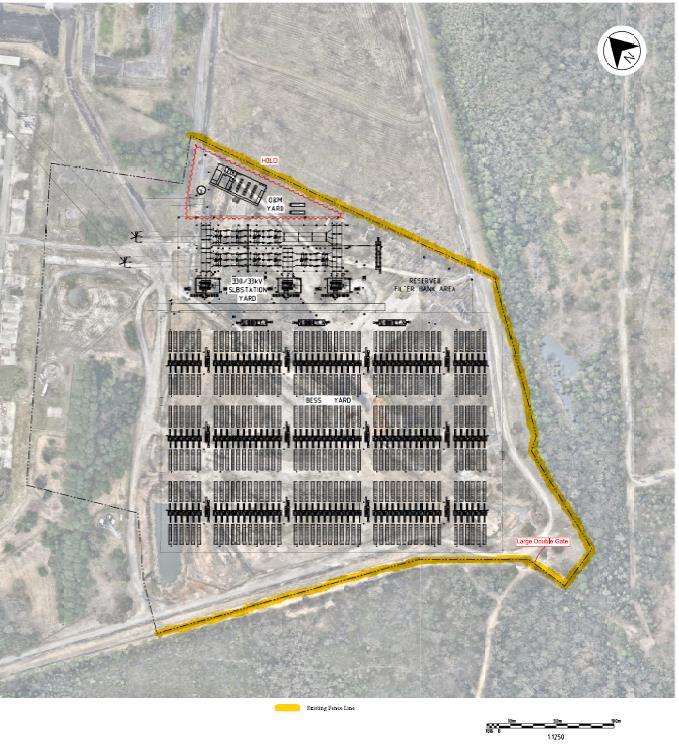















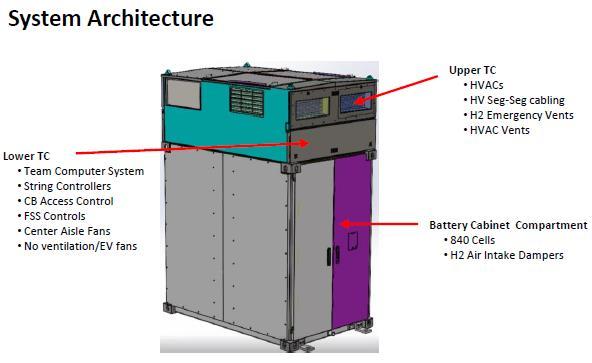

























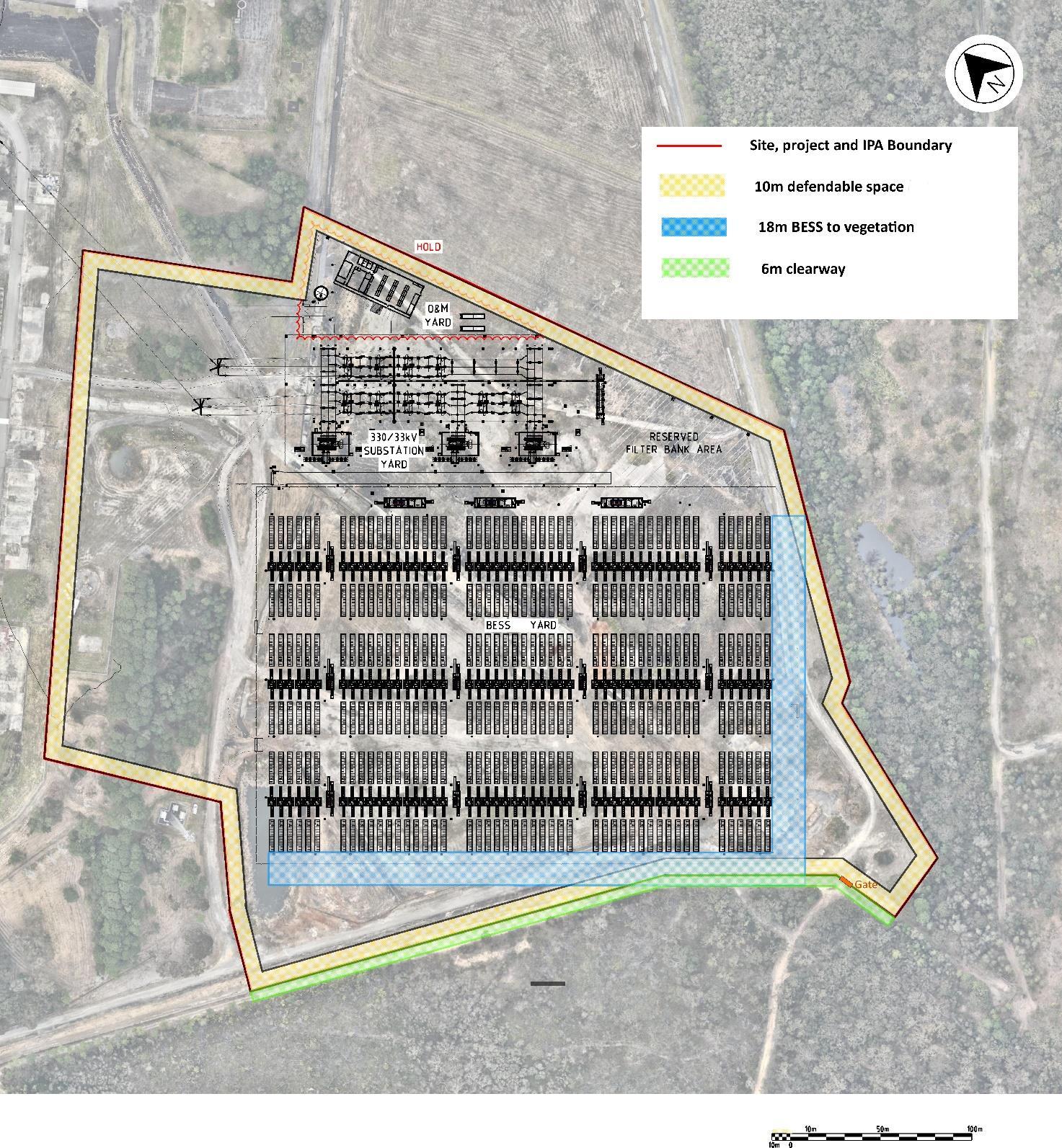



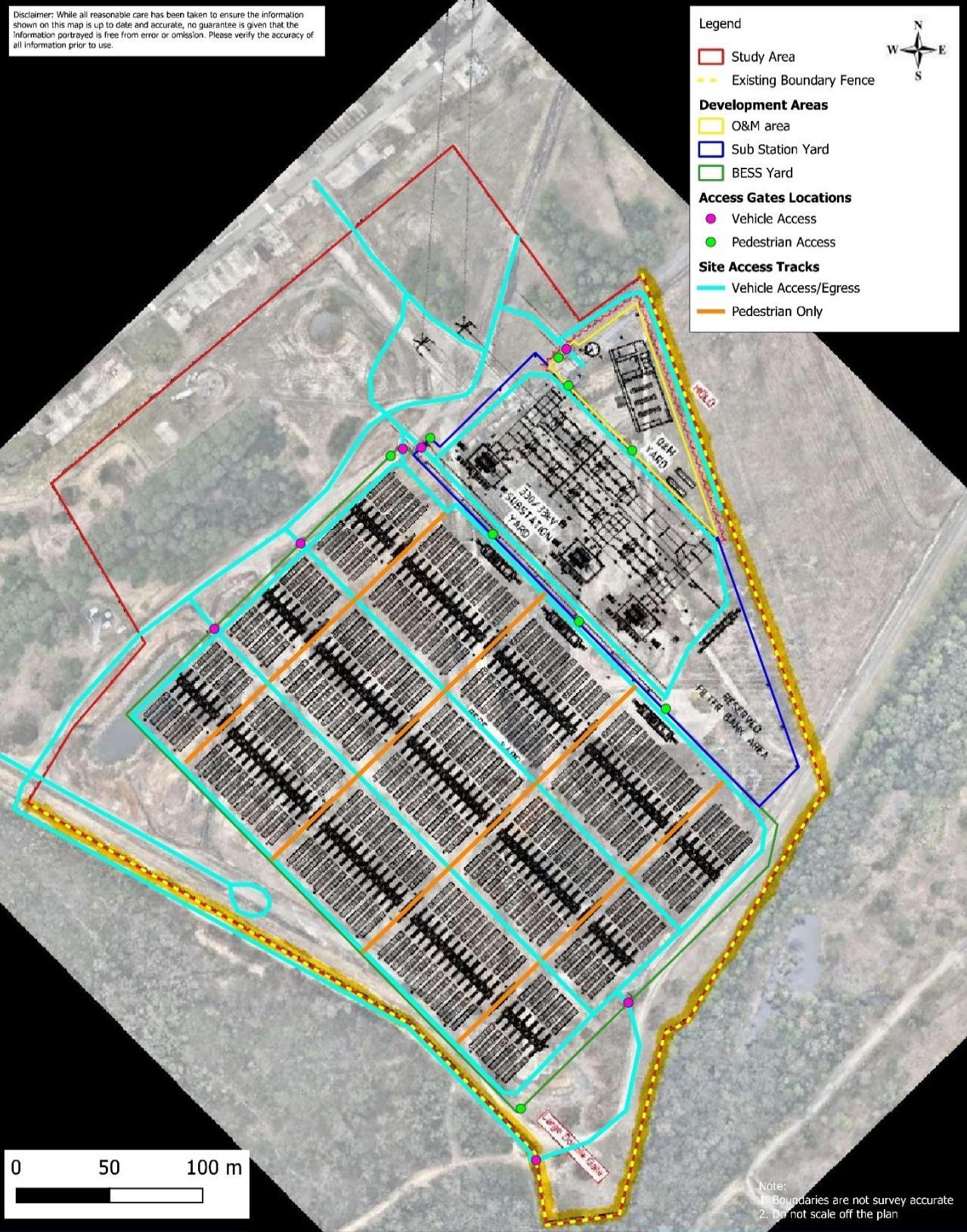





































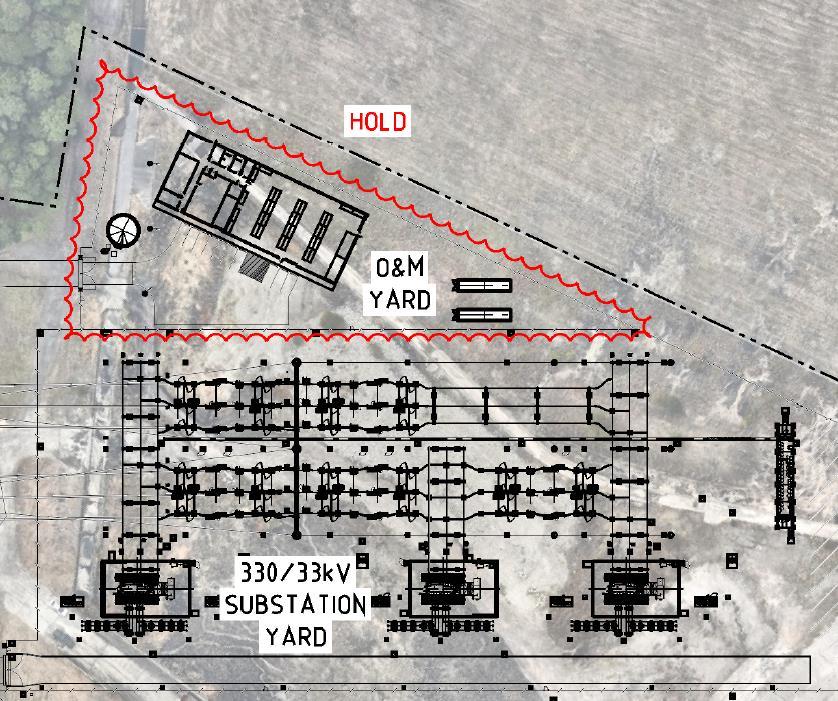




















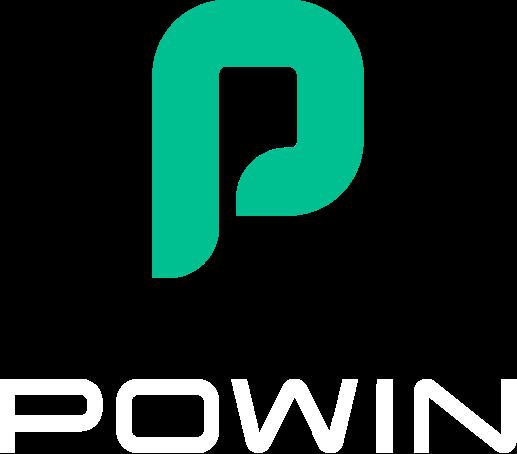


Table of Contents
List of Tables

List of Abbreviations
Abbreviation Definition
AC Alternating Current
AHJ
Authority Having Jurisdiction
BESS Battery Energy Storage System
BMS Battery Management System
CH4 Methane
C2H4 Ethene
C2H6 Ethane
C3H6 Propene
C3H8 Propane
CO Carbon Monoxide
CO2 Carbon Dioxide
DC Direct Current
EMS Energy Management System
ERC Emergency Response Coordinator
FPT Functional Performance Testing
FSS Fire Safety System
H2 Hydrogen
HCL Hydrochloric acid
HCN Hydrogen cyanide
HF Hydrogen fluoride
HVAC Heating, Ventilation, and Air Conditioning
ISO International Organization for Standardization
kVAC Kilovolt Alternating Current
LFP Lithium Iron Phosphate
NFPA National Fire Protection Association
OCPD overcurrent protective devices
OSHA Oregon Safety and Health Administration
PCS Power Conversion System
PFC Pre-Functional Checklist
PPE Personal Protective Equipment
ROC Remote Operations Center
UL Underwriters Laboratories

1. Overview
As per the requirements of the Waratah Super Battery Environmental Impact Statement, the Battery Energy Storage System (BESS) should be stored, installed, operated, and maintained in accordance with the following Battery Management Plan. Furthermore, how to respond to an emergency and handle damaged batteries should be done in accordance with this Plan.
The BESS products contain sealed lithium-ion battery cells that are composed of Lithium Iron Phosphate (LFP). The LFP cells DO NOT contain lithium metal. LFP cells are generally considered the safest lithium-ion chemistry available today. The lithiumion batteries used for the Waratah Super Battery project are tested and certified to ISO 9001.
2. Storage of the Batteries
Spare equipment must be stored in a climate-controlled environment to prevent damage to sensitive electrical components within the minimum and maximum temperature ranges specific in Table 1.
Table 1: Minimum and Maximum Storage Temperatures
Relative humidity should be non-condensing and should not exceed 85%. All equipment, except for Stack750 Segments, should be stored away from direct sunlight.
The lithium-ion batteries storage area should be protected from flooding, based on the annual exceedance probability for the area and subsequent suitable selection of freeboard.
The health and safety of the batteries in storage can be maintained following a fourstage procedure:
1. Initial Storage
2. Stack Voltage Sampling
o Taking voltage measurements of a sample from total
3. Stack Voltage Monitoring
o Performing voltage sampling at regular intervals

4. Stack Recharging (if applicable)
3. Battery Installation & Commissioning
The Centipede Stack750 system is composed of two different segments:
• The Energy Segment
• The Collection Segment
The Centipede Stack750 Energy Segment (also referred to as a Stack) is where energy is stored in battery packs populated by LFP cells. Both the Energy Segments connected to a Collection Segment features temperature range controlled and ventilated outdoor rated enclosures. The energy is accessible through the Collection Segment that connects the lineup to the Power Conversion System (PCS). The PCS can also be referred to as an inverter.
One Collection Segment will be used for nine Energy Segments arranged in three Direct Current (DC) Buses with three Energy Segments behind each bus.
The BESS equipment and connections will be installed by qualified personnel. Training for installers will be provided and installation will have local resources available for support.
The battery system will be insulated and containerized. Each battery container will be verified for installation quality and operational values.
The BESS lineups should be arranged to optimize safe working and operation conditions, accommodating environmental considerations and comply with locally applicable codes and standards). AS5139 is not applicable for the project. Powin understands that Akaysha confirmed that BESS units are over 4.5 meters from site development boundary.
The BESS will follow a commissioning plan to confirm that the BMS is activated and operating during commissioning.
4. Battery Management System + Thermal Management System
The Battery Management System (BMS) is designed to properly manage the batteries state of charge, including battery balancing devices to avoid deterioration and individual cell over/under voltage during operation. The Energy Management System (EMS) includes a safety net of built-in applications which are always installed, always enabled, and always functioning at the highest priority.
If an urgent problem (such as a fire) is detected, the E-Stop Response application opens all DC contactors in the battery array. The E-Stop Response application

prevents any further charge, discharge or balancing by disconnecting and isolating each individual Energy Segment from the DC Bus
If battery conditions approach certain limits, the Battery Safety application limits charging or discharging activity.
The EMS monitors safety parameters at many levels by:
• Responding to safety triggers at low levels.
o For example, the Energy Segment opens contactors and prevents active balancing when it senses certain events. Similarly, a local controller in each Energy Segment responds automatically when it senses a mismatch of DC Bus voltages, voltages out of range, or temperatures out of range.
• Adjusting power commands to keep operations within prudent boundaries. These built-in adjustments are called “derating.”
• Displaying BESS Status Codes to inform appropriate personnel about system conditions at appropriate times.
• Monitoring voltages and temperatures at the battery cell, stack, and DC Bus levels.
Essential safety and monitoring controls exist onsite with the batteries so that a loss of internet at a given site does not prevent its continued operation.
The lithium-ion batteries and Energy Segments include protections and circuit controls including:
• Integrated enclosure insulation
• Monitoring and control at the Energy Segment, lineup, alternating current (AC) block and system level
• Current and temperature sensor logic to monitor short circuit events
• Built-in protection against current surges, both controls and solid state over current protection devices.
• Circuit interrupt device that protects against overcurrent
• Each LFP cell includes a safety vent to provide a controlled release of internal pressure during abnormal conditions and a rigid aluminum exterior provides an added degree of protection against external impacts.
The Thermal Management System includes thermal sensing of the cells to avoid over heating of cells.
A fire detection and suppression system is closely integrated with the BMS and EMS, with a design base and function guided by NFPA 70 and NFPA 855 compliance.

The electrolyte within LFP cells includes a volatile hydrocarbon-based liquid and a dissolved lithium salt (which is a source of the lithium ions). The electrolyte in LFP cells incorporated into BESS products is largely absorbed in the electrodes within the individual cells. In practical terms, there is no liquid electrolyte that is freely flowing within each LFP cell that can easily leak out into the environment once the cell is damaged.
In addition, each cell includes a rigid aluminum exterior providing an added degree of protection against external impacts. Because of this, it is very difficult to mechanically damage an LFP cell resulting in a leak of electrolyte material and the likelihood of an electrolyte spill from the BESS product is very small.
Modules of LFP cells are isolated from each other by steel barriers within BESS products, which act as structural members of the racking system and de facto thermal barriers between modules. These modules are stacked on the steel racking and are enclosed by an outdoor rated steel enclosure (Energy Segment). Each Energy Segment has the capacity to contain the liquid from a large number of LFP cells should there be a leak involving multiple cells.
The cell, steel barriers/racking, and steel external enclosure would have to be significantly damaged, crushed, or mechanically struck for the electrolyte liquid to come into contact with a user of a BESS product. Powin ESS products do not pose a significant liquid electrolyte release hazard based on the architecture and design of the LFP cell and the design and construction of the ESS products around those cells.
The FSS and its integration to the EMS will undergo Functional Performance Testing (FPT) prior to system operation. The purpose of FPT is to verify that all modes of operation function correctly and the mechanical equipment performs as expected.
The Waratah Super Battery project will include: one Pre-Functional Checklist (PFC) and one FPT per segment that covers the following components:
• Heating, Ventilation, and Air Conditioning (HVAC) system and controls
• Hydrogen sensor and emergency ventilation
• Controller response to Fire Suppression System alarming
5. Operations and Maintenance
Technicians should follow procedures and processes based on the standards below while commissioning, maintaining and servicing the BESS. Powin will follow local safety laws and regulations of battery energy storage systems.
• Oregon Safety and Health Administration (OSHA) 1910.147 (c) (4) (ii), the Control of Hazardous Energy (Lockout/Tagout)
• OSHA 1910.332 (b) (3) Training

Battery Management Plan
• OSHA 1910.269 (a) (2) (ii) Electrical Power Generation, Transmission, and Distribution
• NFPA 101.1. National Fire Protection Association, Life Safety Code
• NFPA 70E Standard for Electrical Safety in the Workplace
Only qualified technicians, or qualified and authorized sub-contractors are permitted to work in or around the BESS
On-site inspections and preventative maintenance are needed throughout the life of the product to ensure efficient function. Voltage, current, and temperature are remotely monitored both at the cell-level and Stack-level through the EMS. The data may indicate the need for maintenance outside the schedule in the following tables. An inspection and maintenance regime for the batteries, HVAC, and associated equipment will be implemented on regular established intervals as defined in these tables
Recommended monthly inspections are shown in Table 2.
Table 2: Monthly Inspections
Component Inspection
Exterior of Enclosures
Interior or Enclosures
Cable Tray Area
Spare Parts / Equipment (if applicable)
Site Walk-through
Physical damage, corrosion, and cleanliness
Presence of moisture, dust, and corrosion
Physical damage, corrosion, physical debris, animal infestation, and cleanliness
Inventory and Voltage Checks
General Cleanliness and Security
The following components in Table 3 are recommended for inspection based on the specified frequencies.
Table 3: Electrical Inspections and Maintenance
Quarterly and annual inspections and maintenance are recommended for the HVAC as shown in Table 4

Table 4: HVAC Inspections and Maintenance
Table 5 shows the Fire Safety System (FSS) related components and the recommended cadences for inspection and maintenance.
Table 5: FSS Inspections and Maintenance
Inspect and test smoke and heat detectors
Inspect manual pull station for physical damage (replace as needed)
Ensure access to hazard areas, lines of egress, and manual pull stations are obstructed
Inspect aerosol generators for physical damage or corrosion (replace as needed)
Ensure aerosol generators are unobstructed
Replace aerosol generators at end-of-service life
Replace Hydrogen gas detectors at end-of-service life (10 years from the date code on the sensor)
6. Battery Emergency Response Plan
Emergency planning and training should be provided by the BESS owner or their authorized representative so that facility operations and maintenance personnel and first responders can effectively address foreseeable hazards, associated with the BESS.
This information should aid the owner and the Authority Having Jurisdiction (AHJ) in establishing a site specific emergency operations plan.
Emergency operations training is required for all personnel responsible for the operation, maintenance, repair, servicing, and response of the BESS and must be retrained at least annually. All records of training must be documented and the record of training available onsite.
The BESS products contain sealed lithium-ion battery cells that are composed of lithium iron phosphate (LiFePO4). In addition, R134A: 1,1,1,2-Tetrafluoroethane refrigerant is used in the HVAC units located in the top of the BESS Segments. The Uninterrupted Power Supply (UPS) use Lead Acid Batteries. Safety Data Sheets (SDS) for all items are available upon request.

If a BESS product has been visibly damaged or its outer enclosure has been compromised, practice appropriate high-voltage preventative measures until the danger has been assessed (and dissipated if necessary).
The BESS products are designed to withstand operating ambient temperatures up to 50°C and up to 100% relative humidity with no condensation.
The BESS products exposed to temperatures beyond what is listed above can degrade the battery, resulting in reduced battery service life or, possibly, failure or damage to the LFP cells themselves and should be avoided. This can lead to cells going into thermal runaway and possibly a fire or other thermal event. In addition, exposing the BESS products to heating equipment, localized heat sources, flames or sparks could result in cell thermal runaway reactions and should also be avoided.
To avoid and detect early any damage to the lithium-ion batteries, the battery system will be monitored 24 hours per day, 7 days per week, 365 days per year for alarms and symptoms related to system compromise, performance and or malfunction.
If gases or smoke are observed escaping from a BESS product, evacuate the area as the gases or smoke are likely flammable and could ignite unexpectedly. Immediately notify the supplier and/or the local Fire Department. The BESS product that is suspected of venting should only be approached by trained First Responders equipped with appropriate personal protective equipment (PPE).
Responding to a fire or other hazardous event involving a BESS product should only be performed by trained professionals.
In the unlikely event of a large fire or other thermal event in a BESS product, the following should be performed:
1. Immediately call the local Fire Department, if the alarm system has not already signaled them.
2. Call Remote Operations Center (ROC) at +1 (855) 888-3659. They will contact the Emergency Response Coordinator (ERC).
3. Establish a safety perimeter of 100 feet (30.5 meters) around all sides of the BESS product, and do not allow personnel other than firefighters to enter the safety perimeter.
4. Provide First Responders the site applicable Emergency Response documentation.
If a fire of a lithium-ion battery cannot be extinguished, cooling of adjacent units is available should the proponent wish to use it as an additional risk mitigant, but not required to prevent fire propagation between units. Consider using a wide fog pattern at lowest possible volume application.

The fire inside the Energy Segment is protected by several layers of steel and therefore, water does not have direct access to the batteries. As such, this will not stop the thermal runaway event and may only delay the eventual combustion of the entire BESS product.
A battery fire may continue for several hours, or days, and it may take even longer for the battery packs to cool after they have been fully consumed by a thermal runaway event. A lithium-ion battery fire that has been seemingly extinguished can flare up again if all cells have not been consumed. Therefore, it is advised to allow the ESS product to fully consume itself. The system separation distance has been modelled/tested under UL9540A and has been found to be safe and sufficient.
It is not recommended to initiate manual venting or reactivation of the emergency ventilation system after a fire event. The introduction of outside air can lead to reignition of a fire or lead to explosive conditions.
The LFP cell vent gas composition will depend upon several factors, including the cell state of charge and the cause of cell venting. However, testing has demonstrated that LFP cells release the following compounds when undergoing thermal runaway: Hydrogen (H2), Carbon Monoxide (CO), Carbon Dioxide (CO2), Methane (CH4), Ethene (C2H4), Ethane (C2H6), Propene (C3H6), Propane (C3H8). The compounds listed herein are a mixture of CO, CO2 and H2 and a combination of hydrocarbons. This mixture is flammable; however, no additional toxic compounds (such as HCN, HCL, HF, etc.) that are typically found in the products of combustion of modern fires are released by the cell during venting.
If the vented gas event leads to a fire that involves materials outside of the LFP cell (such as plastics within the module, wire insulation, etc.), combustion products that are typically found in a common plastics fire could be produced. Contact with any products of combustion from a fire or a vented gas without the appropriate Personal Protective Equipment (PPE) should be avoided.
7. Damaged Battery Handling
Damaged batteries should be handled accordingly:
• Contact the supplier immediately if they have not already been notified.
• If any sign of damage is present, remove the battery from service place it in an area away from flammable materials.
• Before handling or transporting a damaged BESS product, wait at least 24 hours or longer. Off-gassing or smoke may be an indication that a thermal reaction is in progress inside the battery enclosure. If evidence of heat, fire, explosion, or off-gas is not observed for 24 hours, the BESS product may be disconnected and moved to a designated location for safe storage.

• A safe storage location for a damaged lithium-ion battery is a location separated from combustibles, buildings, lots lines, etc. by at least 50 feet (15.2 meters). In addition, the storage area should be accessible only by trained professionals who are authorized to evaluate the damaged product. An example of a safe, designated storage space would be fenced in an open yard. Once safely moved to its designated storage location, a damaged BESS product should be monitored during storage for evidence of offgassing, smoke, heat, flames, or any other signs of abnormal activity. If fulltime monitoring of the product is not possible, the supplier can provide additional options to safeguard the BESS product during temporary storage prior to transport.
• Specific instructions for evaluating, disconnecting, and preparing a damaged BESS product for transport can be obtained from supplier. Please contact supplier before performing any activities associated with transporting a damaged BESS product.
If the product has been mechanically damaged in an obvious manner (i.e., the battery enclosure has been dented, cut, or compromised in some other manner), it is possible that cells inside the battery enclosure have been damaged. This could lead to thermal runaway of the damaged LFP cells and possibly spread thermal runaway to neighboring cells.
Before handling or transporting a damaged Powin BESS product, wait at least 24 hours or longer, as instructed by the EMC and Powin’s ROC. Off-gassing or smoke may be an indication that a thermal reaction is in progress inside the battery enclosure. If evidence of heat, fire, explosion, or off-gas is not observed for 24 hours, the Powin BESS product may be disconnected and moved to a designated location for safe storage.

8. Revision History

•
applicable for the project.
• Powin understands that Akaysha confirmed that BESS units are over 4.5 meters from site development boundary.
• The system separation distance has been modelled/tested under UL9540A and has been found to be safe and sufficient
• Powin will follow local safety laws and regulations of battery energy storage systems.
•
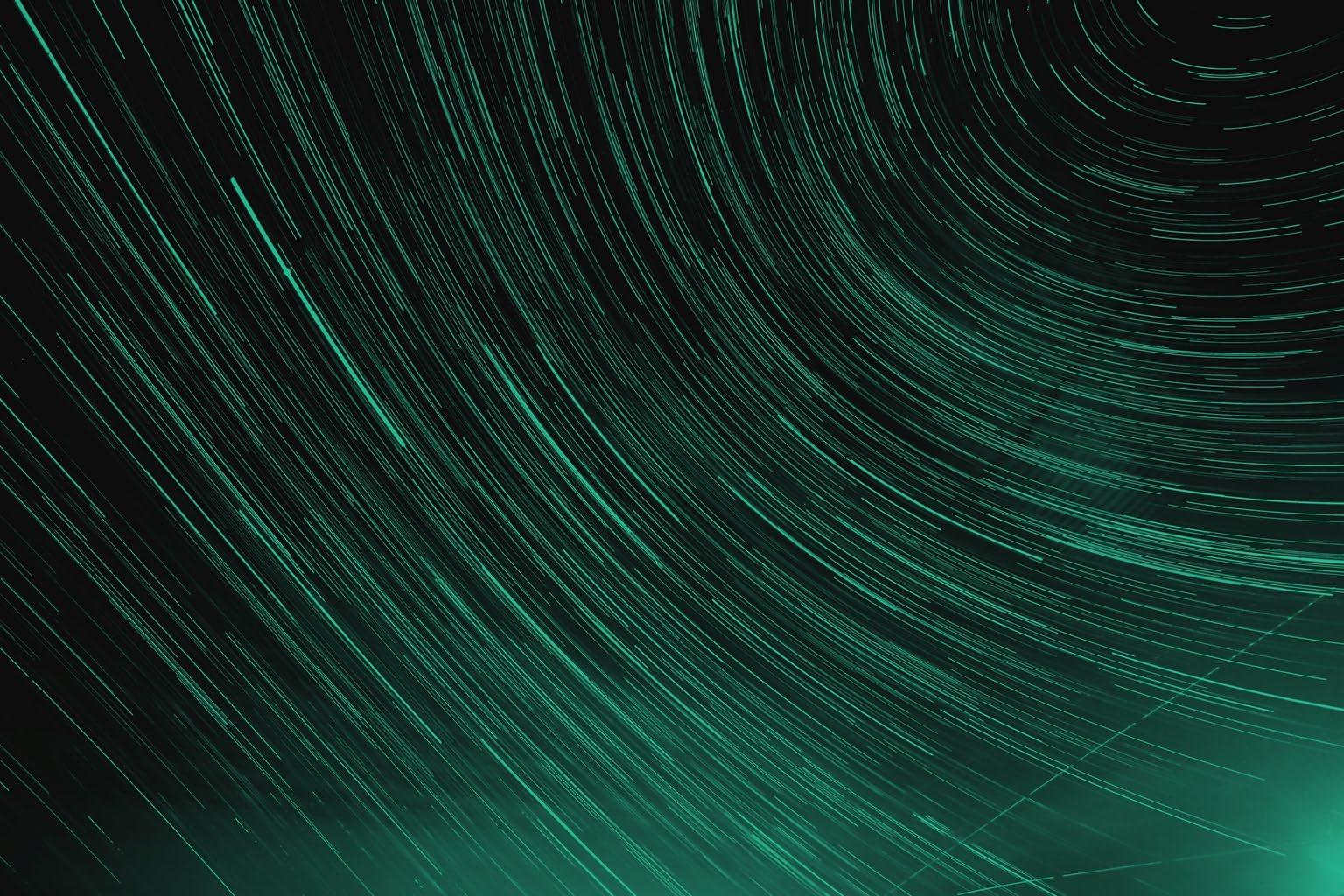




Client: Client: Akaysha
RISK ASSESSMENT DETAILS AND CONTEXT RISK ASSESSMENT DETAILS AND CONTEXT RISK DETAILS RISK DETAILS
Project: Project: Project: Project: RA - Fire Safety Study 'Waratah Big Battery' Job Number: Job Number: AV-J-231071 Folder Number: Folder Number: Folder Number: Folder Number: F22946
Date: Date: Wednesday, 29 March 2023 Author: Author: Author: Author: Colin Barker, Patrick McGaw and Tait Worthington
Risk Context: Risk Context: Risk Context: Risk Context: Risk Assessment for Waratah Fire Safety Study
Waratah Super Battery - Munmorah (Envionmental Impact Statement) - GHD
Waratah Super Battery - Munmorah (Appendix F - Hazard and Risk Assessment) - GHD
Reference Documentation: Reference Documentation:
Waratah Super Battery - Munmorah (Response to Submissions Report) - GHD
Relevant literature papers, Standards, Regulations and Guidelines
The hazard identification workshop aimed to build upon:
- the known hazards of lithium-ion BESS as published within academia
Objectives of Assessment: Objectives of Assessment: of Assessment: of Assessment:
Key Stakeholders: Key Stakeholders:
Note: Note:
Disclaimer: Disclaimer:
- body of literature analysing incidents involving lithium-ion BESS from around the globe
- the analyses already narrated within the PHA for the Waratah Super Battery development
Akaysha
Powin
NSW Department of Planning, Industry & Environment
Wyong Shire Council Neighbours
It should be noted that Advitech Pty Limited prepared these risk assessment workshop results for the client in accordance with the scope of work and specific requirements agreed between Advitech and the customer. These notes were prepared with background information, terms of reference and assumptions agreed with the customer. The results of the workshop are not intended for use by any other individual or organisation and as such, Advitech will not accept liability for use of the information contained in these results, other than that which was intended at the time of writing.
Any representation, statement, opinion or advice expressed or implied in this document is made in good faith, but on the basis that liability (whether by reason of negligence or otherwise) is strictly limited to that expressed on our standard "Conditions of Engagement".
All Intellectual Property rights in this document are Commercial in Confidence and remain the property of Advitech Pty Ltd. This document must only be used for the purposes for which it is provided and not otherwise reproduced, copied or distributed without the express consent of Advitech.

RISK ASSESSMENT METHODOLOGY
RISK ASSESSMENT METHODOLOGY RISK METHODOLOGY RISK METHODOLOGY
Risk Context: Risk Context: Context: Context: Risk Assessment for Waratah Fire Safety Study
Methodology: Methodology: The risk assessment was conducted in the form of a structured workshop, facilitated by Advitech. The results of the workshop were input directly into this worksheet by an Advitech representative. Hazard scenarios were identified in a systematic process, utilising hazard guidewords described below.
Risk Classification: Classification: Hazard scenarios were classified (scored) according to Advitech's Risk Classification System.
Hazards: Hazards: Hazards were defined as "sources of potential harm or situations with the potential to cause a loss". The hazard guidewords used to assist in risk identification were … (refer to standard list, or list individual guidewords here)
Other Definitions: Other Definitions: Other Definitions: Other Definitions: Assets were defined as "tangible and intangible items of value or processes, procedures or tasks performing as intended". The system(s) studied were broken down into assets on the basis of …
ALARP (As Low As Reasonably Practicable) may signify one or more of the following:
• All practical barriers and controls are in place to minimise the risk.
• Likelihood is so remote that risk is tolerable without further action.
• The level of risk is considered tolerable by the community.
• Further risk reduction is either impracticable or the cost is grossly disproportionate to the improvement gained.
General Comments
General Comments & Notes: & Notes:
Results: Results: The results of the risk assessment workshop are given in the following spreadsheet.

















